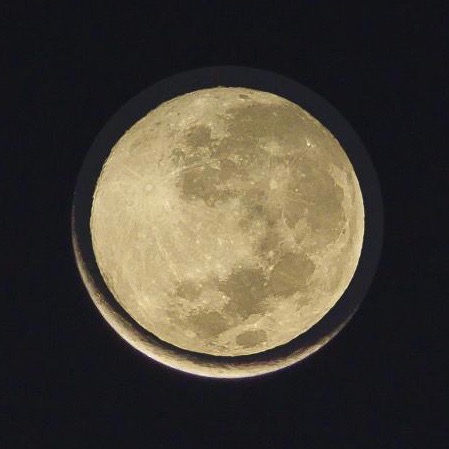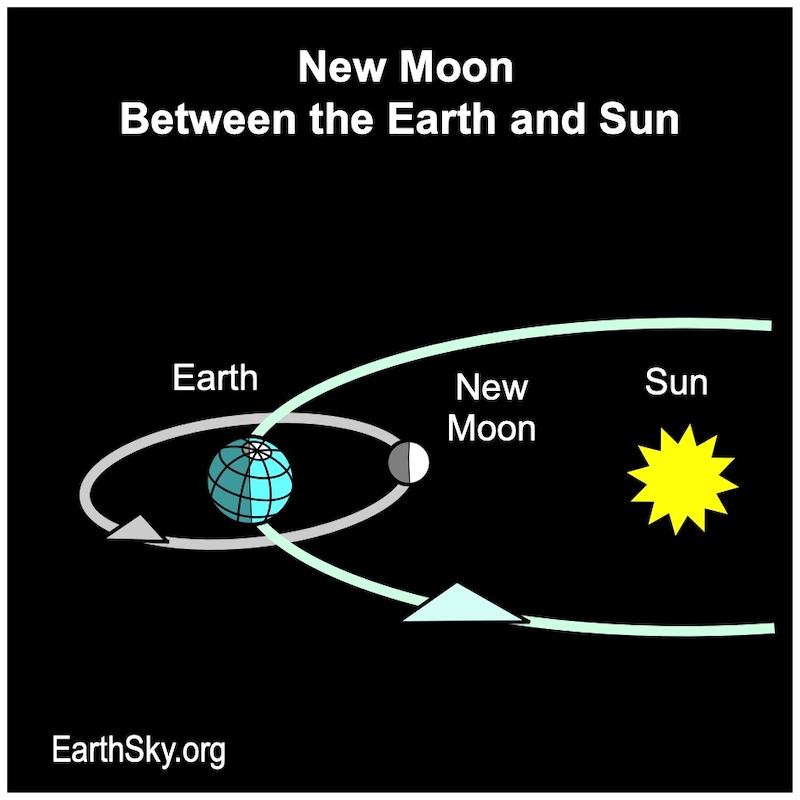Starting today, January 11, 2024, we will have five new supermoons in a row.
5 new supermoons in a row in 2024
According to astrophysicist Fred Espenak – formerly at the Goddard Space Flight Center and best known for his work on eclipse predictions – the January 11, 2024, new moon, at 11:57 UTC (6:57 a.m. CST), is the first in a series of five new moon supermoons in a row.
A new moon is a moon passing between Earth and the sun. And a new supermoon is an exceptionally close new moon. Fred Espenak’s new supermoon table gives us these values – dates and moon distances – for new supermoons in 2024. Contrast these moon distances to the average moon distance of 238,900 miles (384,472 km).
Note dates are based on UTC time so some supermoons may fall on the previous date your local time.
Jan 11: 226,927 miles (365,204 kilometers)
Feb 09: 222,913 miles (358,744 kilometers)
Mar 10: 221,767 miles (356,899 kilometers)
Apr 08: 223,575 miles (359,809 kilometers)
May 08: 227,881 miles (366,739 kilometers)
The new supermoon of March 10, 2024, will be the closest new supermoon for 2024.
And the new supermoon of April 8, 2024, will be the moon that passes in front of the sun causing a total solar eclipse on April 8, 2024.
We had five new supermoons in a row in 2017, 2018, 2019 and 2020. And 2023 had three new supermoons in a row (January, February, March) joining two in late 2022 … making them our most recent five-in-a-row series.
The 2024 lunar calendars are here! Best New Year’s gifts in the universe! Check ’em out here.
What are new supermoons?
It was the astrologer Richard Nolle who coined the term supermoon in 1979. He defines a supermoon as “a new or full moon which occurs with the moon at or near (within 90% of) its closest approach to Earth in a given orbit.” By using this somewhat vague definition, we can say any new moon or full moon coming to within 224,000 miles (361,000 km) of our planet, as measured from the centers of the moon and Earth, counts as a supermoon.
In contrast to full supermoons, which draw a lot of attention and are very popular, new supermoons don’t attract much attention. That’s because you can’t see a new moon. A new moon is between the sun and Earth. It rises and sets with the sun and is lost in the sun’s glare all day. What’s more, the unlit side of a new moon faces Earth, while the lit side (as always) faces the sun. But you might see a very young moon in the western sky briefly after sunset on the evening following a new moon.
By the way, astronomers use also use the term perigean new moon to describe a new moon at perigee, or closest to Earth. When we called them that, nobody paid much attention to them. Supermoon is much catchier!
The exceptionally close new supermoon in January 2023
According to Fred Espenak, the January 21, 2023, new supermoon fell during what he calls an ultimate new moon perigee. Fred Espenak defines an ultimate new moon perigee as when a new moon is less than or equal to 221,580 miles (356,600 km) from Earth. There are only two ultimate new moon perigees this century, according to Fred, and the first one happened on January 10, 2005.
A chart by Fred Espenak on this page indicates that the January 21, 2023, new moon supermoon was the last ultimate new moon perigee for this century. And it was the closest new supermoon until December 14, 2145.

When you can see a new moon
To clarify, it’s not always true that you can’t see a new moon. At favorable times, you can view the new moon silhouette, for example, during a solar eclipse. When the new moon goes directly between the Earth and sun, the result is either a total solar eclipse or an annular eclipse, in which a ring of sunshine surrounds the new moon silhouette. The new moon is closer to Earth at a total solar eclipse and farther away from Earth during an annular eclipse.
The new supermoon of April 8, 2024, will block out the sun causing a total solar eclipse on April 8, 2024.

Earth’s oceans feel new supermoons
And although, generally speaking, we can’t see a new moon, Earth’s oceans feel its impact. At new moon or full moon, the sun, Earth and moon align in space. The gravitational pull on Earth’s oceans is always greatest at such times. These are the spring tides, the highest (and lowest) tides coming twice each month (in contrast to the neap tides, when the variation between high and low tide is at its least, which happen around first and last quarter moon).
A new or full moon at perigee accentuates the spring tides. It creates what some call king tides, or exceptionally high tides, which are noticeable to those living along coastlines.
So, people living along the ocean shorelines might notice the variation in high and low tides for the coming months, around the dates of new moon: in 2024, January 11, February 9, March 10, April 8 and May 8.
One way or another, new supermoons have an impact, whether we see the moon on these days or not!
Bottom line: Starting January 11, 2024, we will have five new moon supermoons in a row. The April 8, 2024, new supermoon will result in a total solar eclipse of the sun.
Resources:
Moon at perigee and apogee: 2001 to 2100
Phases of the moon: 2001 to 2100











